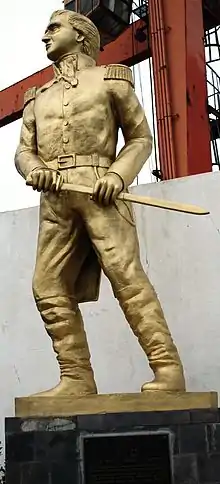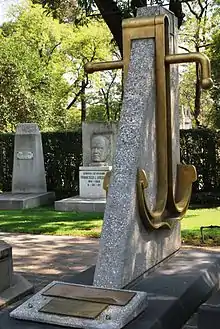Pedro Sáinz de Baranda y Borreiro
Pedro Sáinz de Baranda y Borreiro (13 March 1787 – 16 December 1845) was a Naval Officer, Industrialist and Liberal Politician who served in the Spanish Navy and, having participated in the Mexican War of Independence, is credited with founding the Mexican Navy. During 1835, he served on two occasions as Governor of Yucatán. As an entrepreneur, he founded the first completely mechanized textile factory to use steam-power successfully in Mexico; he is widely regarded as having introduced the Industrial Revolution to the country.[1]
Pedro Sáinz de Baranda y Borreiro | |
|---|---|
 | |
| Governor of Yucatan | |
| In office 3 January 1835 – 18 February 1835 | |
| Preceded by | Francisco de Paula Toro |
| Succeeded by | Sebastián López de Llergo |
| Governor of Yucatan | |
| In office 22 June 1835 – 27 August 1835 | |
| Preceded by | Sebastián López de Llergo |
| Succeeded by | José de la Cruz Villamil |
| Personal details | |
| Born | Pedro Sainz de Baranda y Borreiro 13 March 1787 San Francisco de Campeche, New Spain |
| Died | 16 December 1845 (aged 58) Mérida, Yucatán, Mexico |
| Resting place | Campeche Cathedral (1845–1987) The Rotunda of Illustrious Persons (1987–present) |
| Political party | Liberal Party |
| Spouse(s) | María Joaquina Quijano Cosgaya |
| Children | Pedro Baranda Quijano Perfecto Baranda Quijano María Josefa Baranda Quijano Joaquín Baranda Quijano |
| Parents | Pedro Sáinz de Baranda Cano (father) María Josefa Borreiro y de la Fuente (mother) |
| Education | Escuela Naval Militar |
| Military service | |
| Branch/service | |
| Years of service | 1803–1821 (Spanish Empire) 1821–1830 (Mexico) |
| Rank | Captain |
| Battles/wars | Battle of Traflagar (Anglo-Spanish War (1796–1808)) Siege of San Juan de Ulúa (Mexican War of Independence) |
Born in San Francisco de Campeche, then part of the Captaincy General of Yucatán, he was the son of Pedro Sáinz de Baranda y Cano (1753–1840), a Spanish Colonial administrator and Hidalgo who had arrived in the New World to serve as Minister of the Royal Treasury. The Sainz de Baranda family belonged to the lower Spanish nobility.[2] Aged eleven, Sáinz de Baranda was sent by his parents to Spain to train as a cadet in the Spanish Navy.
As a young Spanish naval officer, he fought in the Anglo-Spanish War (1796–1808), participating with distinction in the Battle of Trafalgar (1805). Fighting aboard the Santa Ana, a Spanish Ship-of-the-Line under the command of Admiral Ignacio Maria de Alava, he received three serious injuries after the fierce engagement held against HMS Royal Sovereign, the British Ship-of-the-Line then under the command of Admiral Cuthbert Collingwood, 1st Baron Collingwood. Due to his bravery in combat, Sáinz de Baranda was promoted to the rank of Lieutenant (Alférez de Navío), aged eighteen.
During the Mexican War of Independence, he founded the Mexican Navy, leading it to victory against the Spanish during the Siege of San Juan de Ulúa. By 1825, the Castle of San Juan de Ulúa in Veracruz was the last part of Mexican territory still in Spanish hands and the Mexican government feared that it would be used strategically by the Spanish to reconquer their former Colony. They ordered a Mexican army, under General Miguel Barragán to lay siege to the Fort, under the command of General José María Coppinger. The incipient Mexican Navy, under the command of Captain Pedro Sainz de Baranda and Borreiro, faced off an invading Spanish convoy, cutting off the arrival of food and reinforcements for the Spanish troops occupying San Juan de Ulúa. The siege lasted between August and November 1825; by the time General Coppinger surrendered the Fort, his troops were already dying of scurvy. The capture of the Castle of San Juan de Ulúa is recognized as the culmination of Mexican independence.[3]
He was the father of Joaquín Baranda – who served as Secretary of Justice (1882–1901), and Pedro Baranda, who served as the first Governor of Morelos in 1869. His great-grandson, José María Pino Suárez, served as the seventh Vice-President of Mexico (1911–13).[4]
Early Years and Participation in the Battle of Trafalgar
He was born in San Francisco de Campeche on 13 March 1787. He was the son of Pedro Sáinz de Baranda y Cano, an official of the Spanish Treasury, and María Josefa de Borreiro y de la Fuente. At the age of 11, in 1798, he was embarked by his parents in a merchant ship that was heading to Spain to begin his instruction as a naval officer. He officially enlisted in the Spanish army on 18 October 1803, where he registered with the rank of midshipman (guardíamarina). In November 1804, he was promoted to Sub-lieutenant (Alférez de fragata) while serving aboard the San Fulgencio under the command of Domingo Grandallana.
Back in 1796, encouraged by Napoleon's military victories (particularly the Rhine Campaign and the Italian Campaign) Manuel Godoy, the Prime Minister of Spain, had signed the Second Treaty of San Ildefonso, establishing a Franco-Spanish alliance and common war against Great Britain. The Treaty of Amiens (1802), signified a temporary truce in hostilities but this was broken two years later after the British carried out a surprise attack on a Spanish squadron of Frigates that was carrying gold and silver bullion to Cádiz. After this incident, the French and Spanish Navies planned to take control of the English Channel, allowing the Grande Armée to invade England.
French and Spanish fleets under the command of French Admiral Villeneuve sailed from the port of Cádiz in the south of Spain on 18 October 1805. Sáinz de Baranda was assigned to the battleship Santa Ana which formed part of a larger squadron under the command of Admiral Federico Gravina. Off the Cape Trafalgar, the squadron encountered the British fleet under Admiral Lord Nelson, recently assembled to meet this threat.
During the engagement between the Santa Ana and the H.M.S Royal Sovereign, Sainz de Baranda sustained serious wounds; after the engagement, he was raised to the rank of Lieutenant. He was only eighteen.
In 1812, he was elected as a deputy to the Cortes of Cádiz, which were tasked with drafting the Spanish Constitution of 1812.
By order of the Supreme Naval Command, he returned to his native Campeche in 1815 where he served in the Engineer Corps, tasked with supervising and strengthening the fortifications. He remained loyal to the Spanish Crown for fifteen more years until 1821, when the independence of Mexico was consummated under the Treaty of Córdoba.
Foundation of the Mexican Navy and Siege of San Juan de Ulúa
After the fall of the Mexican Empire, Sáinz de Baranda was elected deputy to the constituent courts of Mexico, tasked with drafting the Constitution of Mexico (1824).
In 1822, he began working for the newly formed Mexican Ministry of the Navy and tasked with forming a fleet in the port of Veracruz. In the following years, he received the appointments of captain of the port of Campeche and that of the naval commander of the State of Yucatán. In 1825 he was appointed commander-general of the port of Veracruz.
In this capacity, he made the decision to attack the Castle of San Juan de Ulúa as it was still occupied by Spanish troops. After General Miguel Barragán tried and failed to take the Castle of San Juan de Ulúa by land, Captain Sainz de Baranda was tasked with organizing a naval blockade of the fortress, thereby preventing Spanish ships from resupplying their garrison. Sainz de Baranda organized a fleet of warships made up of 200 sailors and 100 gunners as well as a frigate and eight corvettes.
The fortress finally surrendered on 23 November 1825. By this joint military and naval action, Mexico's independence was fully consolidated and Spain lost her final foothold in Mexican territory. For his role in these events, Pedro Sainz de Baranda is considered the founder of the Mexican Navy.
To honor these facts, the "Navy Day" was instituted in Mexico on 23 November by a presidential decree signed by Carlos Salinas de Gortari.[5]
Industrialist and Founder of Aurora de Yucatán
In 1834, together with John McGregor, a Scottish businessman and his silent partner, he opened Aurora Yucateca, the first completely mechanized textile factory to use steam power successfully in Mexico; he is widely regarded as having introduced the industrial revolution to the country.[6]
By 1840, Sáinz de Baranda's health had deteriorated notably and he had all but retired from public life, focusing entirely on his industrial pursuits and collaborating with the American explorer John Lloyd Stephens in his research work on the Mayan culture in Yucatan.[7] This collaboration is the partial subject of the book Stephens wrote with Frederick Catherwood, titled Incidents of Travel in Yucatán.
After the death of Sáinz de Baranda, the city of Valladolid was the victim of widespread destruction after the Mayan rebellion which threatened the population of European descent resident in the Yucatán Peninsula during the War of the Castes. Aurora de Yucatán was victim of such vandalism; the factory, unable to sustain the pressure of losing her founder and being subjected to civil war, was forced to shutdown.
Politics and his last years
From 1830 he began a more political life holding various public positions, these included serving as Mayor of Valladolid and Vice-Governor of Yucatán. During 1835, he served during two brief periods as Governor of Yucatan.

Sáinz de Baranda died in the city of Mérida on 16 December 1845 at the age of 58, his remains were transferred to the city of Campeche and deposited in Campeche Cathedral from which they were exhumed in 1987 to be transferred and re-buried in the Rotunda of the Illustrious Persons in Mexico City on 13 March of that same year, with the corresponding naval honors.
Descendants
His son Joaquín Baranda Quijano served as Governor of Campeche (1871–77), Senator from Campeche and Secretary of Justice (1882–1901). Another of his sons, General Pedro Baranda, played an important role in founding the State of Campeche (1862) and Morelos (1869), serving as the first governor of the latter State; later, he was appointed interim governor of the State of Tabasco (1877), and also fought for the liberal forces in the Reform War.
His great-grandson, José María Pino Suárez, served as Secretary of Justice (1910–11), Governor of Yucatán (1911), President of the Senate (1911–12), Secretary of Education and Fine Arts (1912–13) and Vice-President of Mexico (1911–13).[8]
References
- Cline, Howard F. (1947). "The Aurora Yucateca And The Spirit of Enterprise in Yucatán, 1821–1847". The Hispanic American Historical Review. 27 (1): 30–60. JSTOR 2508590.
- "Revolucionarios con clase. Familia Sainz de Baranda, 1750–1850" (PDF). Retrieved 8 February 2020.
- Menéndez, Carlos R. (1937). Noventa años de historia de Yucatán (1821–1910). Mérida, Yucatán, México: Compañía Tipográfica Yucateca. pp. 423–424.
- Ai Camp, Roderic (1991). Mexican Political Biographies 1884–1934 (First ed.). The University of Texas Press. pp. 1925–1926.
- Secretaría de Marina (2 July 2019). "Día de la Armada de México | Secretaría de Marina | Gobierno". gob.mx. Retrieved 8 February 2020.
- "Aurora Yucateca – Part II". yucatanliving.com. Retrieved 16 February 2020.
- Casares G. Cantón, Raúl; Duch Colell, Juan; Antochiw Kolpa, Michel; Zavala Vallado, Silvio; et al. (1998). Yucatán en el tiempo. ISBN 970-9071-04-1.
- Ai Camp, Roderic (1991). Mexican Political Biographies 1884–1934 (First ed.). The University of Texas Press. pp. 1925–1926.